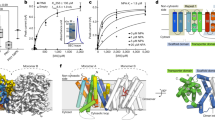Abstract
An hypothesis is advanced that the hormonal activity attributable to the heterogeneous group of plant growth compounds called auxins is a direct result of the ability of the bound auxin to undergo a simultaneous conformational change or reorientation with the receptor, while in the binding site.
This is a preview of subscription content, access via your institution
Access options
Subscribe to this journal
Receive 51 print issues and online access
$199.00 per year
only $3.90 per issue
Buy this article
- Purchase on Springer Link
- Instant access to full article PDF
Prices may be subject to local taxes which are calculated during checkout
Similar content being viewed by others
References
Kögl, F., Haagen-Smit, A. J. & Erxleben, H. Hoppe-Seyler's Z. physiol. Chem. 228, 90–103; 104–112 (1934).
Koepfli, J. B., Thimann, K. V. & Went, F. W. J. biol. Chem. 122, 763–780 (1938).
Veldstra, H. Enzymologia 11, 97–136; 137–163 (1944); A. Rev. Pl. Physiol. 4, 151–198 (1953).
Jönsson, A. in Encyclopaedia of Plant Physiology 14, 959–1006 (Springer, Berlin, 1961).
Fredga, A. & Åberg, B. A. Rev. Pl. Physiol. 16, 53–72 (1965).
Audus, L. J. Plant Growth Substances 1: Chemistry and Physiology (Leonard Hill, London, 1972).
Tukey, H. B., Went, F. W., Muir, R. M. & van Overbeek, J. Pl. Physiol. 29, 307–308 (1954).
Fawcett, C. H., Wain, R. L. & Wightman, F. Ann. appl. Biol. 43, 342–354 (1955).
Osborne, D. J., Blackman, G. E., Novoa, S., Sudzuki, F. & Powell, R. G. J. exp. Bot. 6, 392–408 (1955).
Toothill, J., Wain, R. L. & Wightman, F. Ann. appl. Biol. 44, 547–560 (1956).
Leaper, J. M. F. & Bishop, J. R. Bot. Gaz. 112, 250–258 (1951).
Kögl, F. & Kostermans, D. G. F. R. Hoppe-Seyler's Z. physiol. Chem. 235, 201–216 (1935).
Hoffman, O. L., Fox, S. W. & Bullock, M. W. J. biol. Chem. 196, 437–441 (1952).
Muir, R. M. & Hansch, C. Pl. Physiol. 28, 218–232 (1953).
Jönsson, Å Svensk kern. Tidskr. 67, 166–187 (1955).
Hansen, B. A. M., Burström, H. & Teär, J. Physiologia Pl. 8, 987–1002 (1955).
Luckwill, L. C. & Woodcock, D. in The Chemistry and Mode of Action of Plant Growth Substances (eds. Wain, R. L. & Wightman, F.) 195–204 (Butterworths, London, 1956).
Åberg, B. Physiologia Pl. 4, 627–640 (1951).
Burström, H. Physiologia Pl. 8, 174–188 (1955).
Kaethner, T. M. thesis, Univ. Cambridge (1977).
Veldstra, H. in The Chemistry and Mode of Action of Plant Growth Substances (eds Wain, R. L. & Wightman, F.) 117–133 (Butterworths, London, 1956).
Minarik, C. E., Ready, D., Norman, A. G., Thompson, H. E. & Owings, J. F. Jr Bot. Gaz. 113, 135–147 (1951).
Åberg, B. in The Chemistry and Mode of Action of Plant Growth Substances (eds Wain, R. L. & Wightman, F.) 93–116 (Butterworths, London, 1956).
Wain, R. L. & Wightman, F. Ann. appl. Biol. 45, 140–157 (1957).
Kefford, N. P. & Caso, O. H. Bot. Gaz. 127, 159–163 (1966).
Haagen-Smit, A. J. & Went, F. W. Koninkl. Akad. Wetenschap. Amsterdam, Proc. Sect. Sci. 38, 852–857 (1935).
Thimann, K. V. Pl. Physiol. 27, 392–404 (1952).
Matell, M. K. LantbrHögsk. Annlr. 20, 205–240 (1953); Arkiv. Kemi 6, 365–374, (1953).
Åberg, B. K. LantbrHögsk. Annlr. 20, 241–295 (1953).
Aberg, B. K. LantbrHögsk Annlr. 35, 3–27 (1969).
Kögl, F. Naturwissenschaften 25, 465–470 (1937).
Kögl, F. & Veerkaaik, B. Hoppe-Seyler's Z. physiol. Chem. 280, 167–176 (1944).
Åberg, B. K. LantbrHögsk. Annlr. 24, 375–395 (1958)
Åberg, B. K. LantbrHögsk. Annlr. 26, 229–238 (1960).
Burström, H. Physiologia Pl. 4, 470–485 (1951).
Went, F. W. Archs Biochem. 20, 131–136 (1949).
Hansch, C., Muir, R. M. & Metzenberg, R. L., Jr, Pl. Physiol. 26, 812–821 (1951).
Smith, M. S. & Wain, R. L. Proc. R. Soc. B. 139, 118–127 (1951).
Thimann, K. V. A. Rev. Pl. Physiol. 14, 1–18 (1963).
Author information
Authors and Affiliations
Rights and permissions
About this article
Cite this article
Kaethner, T. Conformational change theory for auxin structure–activity relationships. Nature 267, 19–23 (1977). https://doi.org/10.1038/267019a0
Received:
Accepted:
Issue Date:
DOI: https://doi.org/10.1038/267019a0
This article is cited by
Comments
By submitting a comment you agree to abide by our Terms and Community Guidelines. If you find something abusive or that does not comply with our terms or guidelines please flag it as inappropriate.



